| Life Cycle: Eggs, Larvae, Pupae, Eclosion |
An understanding of the life cycle and general
biology of lepidoptera adds much to the overall experience of moth
photography. There is an excellent on-line syllabus and illustrated Entomology
Tutotial Series offered by North Carolina State University. This
is a fine resource for your use in finding answers to many puzzling
questions about the insects you encounter. I thank Professor John R.
Meyer in the Deptartment of Entomology there for permission to
reproduce below a portion of the chapter dealing with holometabolous
development.
|
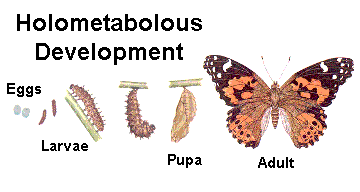 |
Holometabolous insects have immature
forms (larvae) that are very different from adults. Larvae
are "feeding machines", adapted mostly for consuming food and
growing in size. They become larger at each molt but do not
acquire any adult-like characteristics. When fully grown, larvae
molt to an immobile pupal stage and undergo a complete
transformation. Larval organs and appendages are broken down
(digested internally) and replaced with new adult structures that
grow from imaginal discs, clusters of undifferentiated
(embryonic) tissue that form during embryogenesis but remain dormant
throughout the larval instars. The adult stage, which usually bears
wings, is mainly adapted for dispersal and reproduction.
| |
| Appearance |
Larval Type |
Common Name |
Description |
Examples |
 |
Eruciform |
Caterpillar |
Body cylindrical with short thoracic legs and 2-10 pairs of
fleshy abdominal prolegs |
Butterflies and Moths |
 |
Vermiform |
Maggot |
Body fleshy, worm-like. No head capsule or walking
legs |
House fly, flesh fly |
| Appearance |
Pupal Type |
Common Name |
Description |
Examples |
 |
Obtect |
Chrysalis
Pupa |
Developing appendages (antennae, wings, legs, etc.) held tightly
against the body by a shell-like casing. Often found enclosed
within a silken cocoon. |
Butterflies and moths |
 |
Coarctate |
Puparium |
Body encased within the hard exoskeleton of the next-to-last
larval instar |
Flies | |
Holometabolous Development data from ENT 425 Tutotial
Series at NC State University © Professor John R. Meyer, Dept. of
Entomology
|
| Eggs |
|
|
| Larvae or Caterpillar Stage |
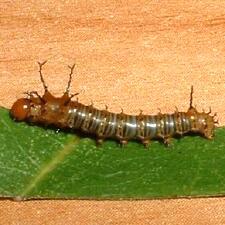 Imperial Moth -
Eacles imperialis Imperial Moth -
Eacles imperialis
1st instar - © Stuart Schwartz |
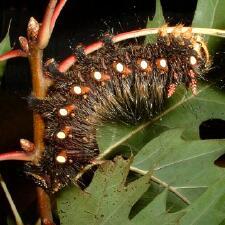 Imperial Moth
- Eacles imperialis Imperial Moth
- Eacles imperialis
early 5th instar - © Stuart Schwartz
|
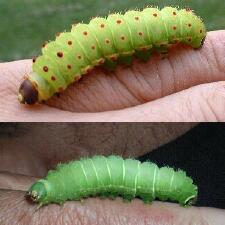 Luna Moth -
Actias luna Luna Moth -
Actias luna
color forms - © Stuart Schwartz |
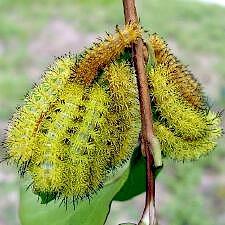 Io Moth - Automeris io Io Moth - Automeris io
group behavior - © Machele White
| |
Larvae may go through four, five (usually) or more
instars during development. This may require several weeks or months and
even several years in a few cases. Coloration and markings may change
significantly from instar to instar. In some species there may be
distinctive color forms in the larvae even when they originate from the
same egg mass/parentage.
|
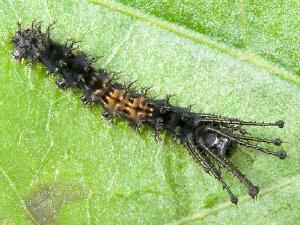 Royal Walnut Moth -
Citheronia regalis Royal Walnut Moth -
Citheronia regalis
early instar - © Troy Bartlett |
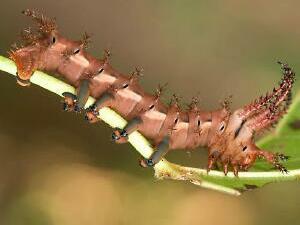 Royal Walnut Moth -
Citheronia regalis Royal Walnut Moth -
Citheronia regalis
intermediate instar - © Troy Bartlett
|
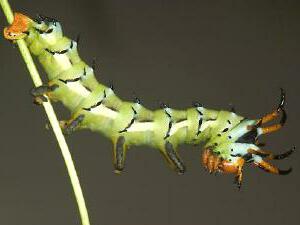 Royal Walnut Moth -
Citheronia regalis Royal Walnut Moth -
Citheronia regalis
late instar - © Troy Bartlett
| |
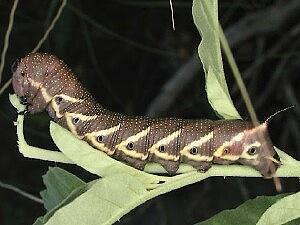 5-spotted Hawkmoth -
Manduca quinquemaculata 5-spotted Hawkmoth -
Manduca quinquemaculata
black form - © Jim McClarin |
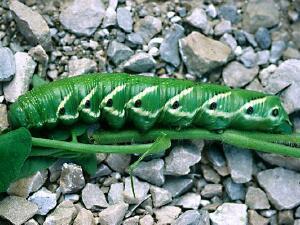 5-spotted Hawkmoth -
Manduca quinquemaculata 5-spotted Hawkmoth -
Manduca quinquemaculata
green form - © Janice Stiefel |
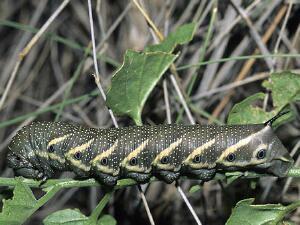 5-spotted Hawkmoth -
Manduca quinquemaculata 5-spotted Hawkmoth -
Manduca quinquemaculata
black form - © Bryan Reynolds
| |
| Cocoon and Pupa/Chrysalis |
 a. - ©
Joyce Gross a. - ©
Joyce Gross |
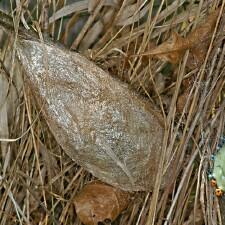 b. - © Pete Ganzel b. - © Pete Ganzel |
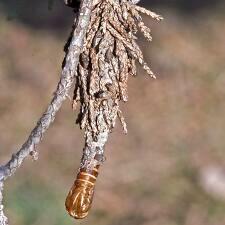 c. - © Charles
Lewallen c. - © Charles
Lewallen |
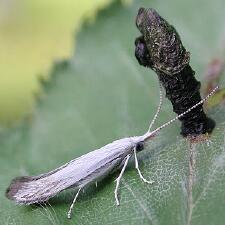 d. - © John
Himmelman d. - © John
Himmelman |
-
Cocoon containing corpse of a Western Tussock Moth
pupa and, beside it, the puparium of a parasitoid Tachinid Fly.
-
A well crafted silk cocoon of the Cecropia Moth,
Hyalophora cecropia.
-
A Bagworm Moth case used for protection during the
larval phase, it serves also as a pupation site. Wingless
females never leave the case. In this instance a male has
eclosed to adulthood leaving behind the puparium or exuvium now
projecting from the tip of the case. It will locate a
female when she releases a pheromone attractant, and mate with
her through a small opening in her protective case.
-
Numerous micromoths are known as casebearing moths
and utilize diversely designed cases in which to pupate. This is
the Pistol Casebearer Moth, Coleophora
atromarginata, named after the shape of its case.
|
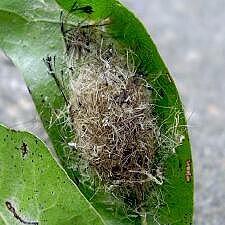 e. - © Machele
White e. - © Machele
White |
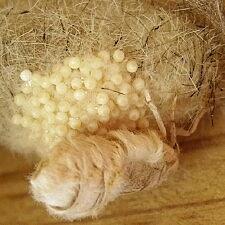 f. - © Machele
White f. - © Machele
White |
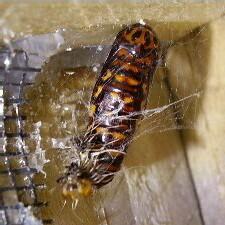 g. - ©
Machele White g. - ©
Machele White |
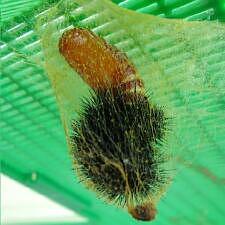 h. - © Machele
White h. - © Machele
White |
-
Cocoon of the Southern Tussock Moth, Dasychira
meridionalis, richly lined with the caterpillar's hairs
added to the silken enclosure.
-
Wingless female of the Live Oak Tussock Moth,
Orgyia detrita with her eggs on top of the cocoon from
which she eclosed. Here we have three life stages in a
single photo. She will probably cover the egg mass with a frothy
protective coating.
-
Some species use little or no silk to conceal
their pupation site, especially when it is their custom to
pupate in leaf litter. This is the Bella Moth, classified
here as part of the complex species Utetheisa ornatrix.
-
Frequently, skin of the last instar caterpillar is
found in the cocoon with the pupa. In this case the caterpillar
of a Giant Leopard Moth, Hypercompe scribonia did
not incorporate its body hairs into the cocoon. The brown
puparium seen here will blacken prior to eclosure.
| |
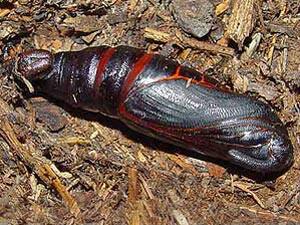 i. - ©
Tim Dyson - Sphinx kalmiae i. - ©
Tim Dyson - Sphinx kalmiae |
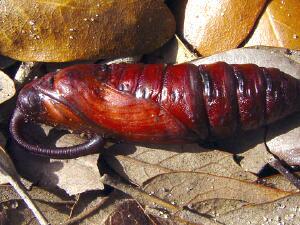 j. - © Alan
Chin-Lee - Manduca rustica j. - © Alan
Chin-Lee - Manduca rustica |
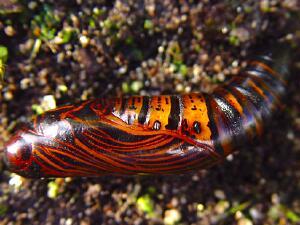 k. - © Alan
Chin-Lee - Erinnyis ello k. - © Alan
Chin-Lee - Erinnyis ello |
-
Pupae Jewels found in leaf litter. Laurel Shinx
Moth in Ontario.
-
Rustic Sphinx Moth in Florida.
-
Ello Sphinx Moth in Florida.
| |